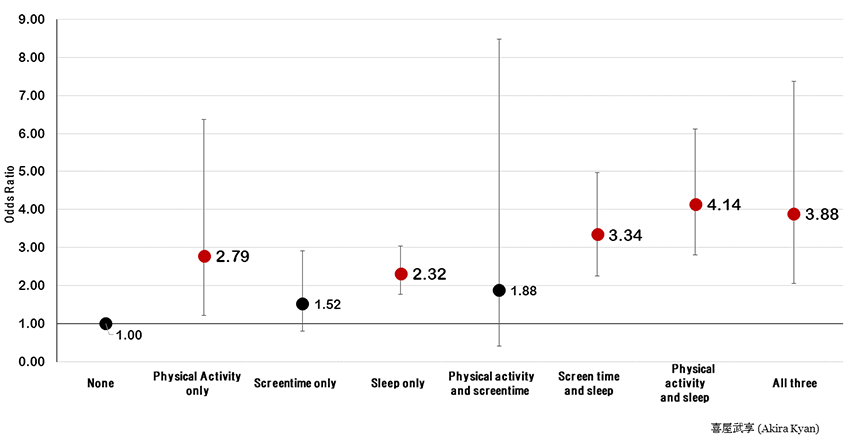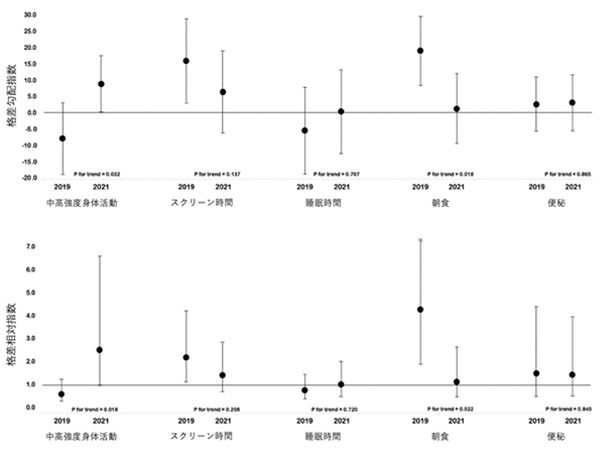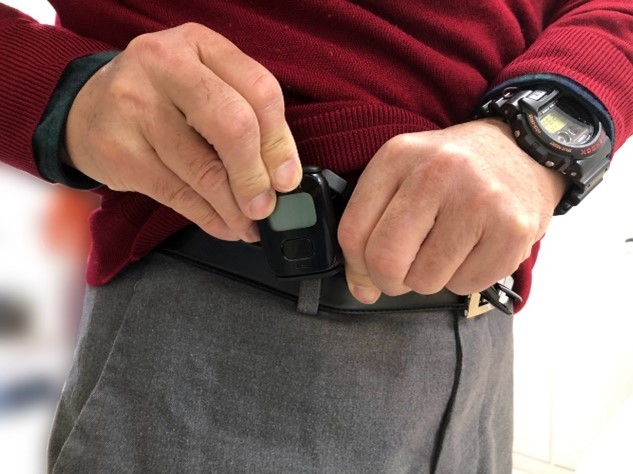Many studies have reported that children and adolescents need sufficient sleep and exercise, and should minimize the time they spend looking at TV, computer or phone screens. But does adhering to government recommendations regarding these behaviors have a positive effect on the health of the next generation?
A Japanese research collaboration has discovered associations between elementary and junior high school students’ self-reported health and how well they met the 24-hour movement guidelines (for sleep, physical activity and screen time). This is believed to be the first such study to investigate these associations in a Japanese population. The results highlight the importance of measures to promote children and adolescents’ health that take into account the interconnected relationships between these three behaviors.
This study was conducted by Kobe University’s Assistant Professor KYAN Akira (Graduate School of Human Development and Environment) and University of the Ryukyus’ Professor TAKAKURA Minoru (Epidemiology/Health Education, Department of Health Sciences, Faculty of Medicine) and Professor MIYAGI Masaya (Faculty of Education/Graduate School of Community Engagement and Development).
These results were published in the international academic journal Public Health on November 18, 2022.
Main points
- Several western countries have produced guidelines detailing the recommended number of hours for physical activity, sedentary behavior and sleep over a 24-hour period.
- An increasing number of studies have indicated a relationship between meeting these guidelines and overall health, however little research has been conducted in Japan.
- There was a difference in the percentage of elementary school students (39.2%) and junior high school students (10.4%) who didn’t meet all of the recommended guidelines.
- For junior high school students, meeting any of the following guideline recommendations was correlated with good health: ‘only physical activity’, ‘only sleep’, ‘screen time and sleep’, ‘physical activity and sleep’ or ‘all three’.
- These results suggest that an effective way of promoting good health among adolescents (particularly junior high school students) would be to focus on recommending that they get a suitable amount of sleep at night, while encouraging physical activity during the day to complement this.
Research Background
A person’s activities over a 24 hour period can be divided into physical activity, sedentary behavior and sleep. These three behaviors are complementary in that if the amount of one increases, then the others decrease. It is well known that each of these behaviors is related to children and adolescents’ health, however it is necessary to investigate which combinations of these 3 behaviors over a one day period (24 hours) benefit health in order to obtain an accurate understanding.
Recently, the importance of ‘Movement Behavior’ has gathered momentum, especially in Western countries, with an increasing number of studies being carried out to assess their effects on health. Canada and Australia have released 24-hour Movement Guidelines that show the recommended number of hours for each behavior in children and adolescents. These guidelines recommend at least 180 minutes of physical activity (of which one hour should be medium to high intensity exercise), under 2 hours of screen time, and at least 8 to 10 hours of sleep (9 to 11 hours for 5 to 11 year olds) each day. The Asia Pacific Region is also planning to develop similar guidelines.
Very little research has been carried out in Japan on the relationship between meeting these guidelines and individuals’ health indicators. In the face of mounting evidence from Western countries, it is necessary to conduct research on Japanese populations to assess whether or not these guidelines should be promoted to children and adolescents in Japan.
Accordingly, this study aimed to investigate the relationship between 24-hour guideline adherence and self-reported health in Japanese elementary and junior high school students. They also investigated differences between the age groups, especially because the percentage of adolescents self-reporting health issues tends to increase with age.
Research Findings
The participants in this study were 2,408 5th graders (10-11 year olds, 52.2% girls) from 31 elementary schools and 4,360 8th graders (13-14 year olds, 49.9% girls) from 30 junior high schools in Okinawa, who completed questionnaires. Participant data was collected via cluster sampling with the schools as one unit. The schools included in this study were selected in an unbiased manner via probability proportional sampling; this was done to ensure a particular school’s students or schools in a particular region weren’t over-represented in the results.
The researchers used logistic regression analysis to investigate the association between adherence to guideline recommendations (on sleep, physical activity and screen time) and self-reported health. Sex, weight (BMI), social economic status, parental support, satisfaction with school, and academic pressure were included as covariates.
The results of the analysis showed that meeting the guidelines for ‘screen time and sleep’ was associated with good self-reported health in elementary school students. For junior high school students, associations were found between good self-reported health and meeting any of the following combinations: ‘physical activity only’, ‘sleep only’, ‘screen time and sleep’, ‘physical activity and sleep’, ‘all 3 guidelines’ (Figure 1).

The graph numerically indicates how much self-reported health increased when different guidelines were met (‘no guidelines met’ is given a score of 1). The odds ratios have 95% confidence intervals (Scores not containing1 are considered significant associations. Significant associations are indicated by red dots.).
Further Developments
Most research up until now has focused on showing the importance of separate healthy behaviours individually, and has not assessed the impact of combinations of such behaviour on health. The current study has demonstrated that promoting a combination of appropriate sleeping duration and sufficient physical activity could have a beneficial effect on the health of children and adolescents (especially junior high school students).
However, more research needs to be conducted in order for this research group to be able to recommend effective measures to improve the health of children and adolescents. One limitation of this study’s design is that causality could not be established; in other words it is not possible to find out why some students did or did not meet the guidelines. The group will continue this research by investigating the associations to other indicators of health and establish causality through longitudinal studies, interventional studies and objective measurements of each behaviour and outcome.
Glossary
1. Longitudinal study
A study in which the same variables are repeatedly observed over a period of time to detect any changes.
Journal Information
Title
DOI
10.1016/j.puhe.2022.10.012
Authors
Akira Kyan, Minoru Takakura, Masaya Miyagi
Journal
Public Health










